Charge Point Home Flex EV Charger Review
The ChargePoint Home Flex is a premium EV charger, offering fast charging, wide compatibility, and smart features for reliable, future-ready home use.
This is EV Charger Experts’ ChargePoint Home Flex review.
I’m a licensed electrician with years of experience installing Level 2 chargers in residential garages, driveways, and small commercial settings. I’ve personally installed the Home Flex multiple times, both hardwired and plug-in, and tested it with different EVs ranging from Teslas to Chevy Bolts.
Summary
The ChargePoint Home Flex is one of the most versatile and polished EV chargers available today. It combines excellent build quality, reliable performance, and industry-leading smart features. While it isn’t the cheapest option, its UL certification, flexible amperage settings (16A–50A), and sleek design make it worth serious consideration.
However, installation details matter. Improper wire sizing, breaker selection, or mounting height can create long-term issues. That’s where this review adds insights most buyers don’t hear.
Overview & Why You Should Consider It
The Home Flex is ChargePoint’s flagship residential charger, offering up to 50 amps (12 kW) of output. Unlike cheaper alternatives, it’s adjustable; you can dial it down during installation to match your electrical service (20A, 30A, 40A, or 50A breaker).
That flexibility makes it ideal for homes with limited electrical capacity, or for homeowners planning future upgrades. For example, I installed one in a 1960s home where we initially limited it to 32A on a 40A breaker, then later bumped it up to 48A after the service panel was upgraded. That kind of “future-proofing” is rare in competing models.
My Experience with the Home Flex
From an installer’s perspective, this charger is one of the cleanest to work with. The backplate design makes wiring straightforward, and the terminal screws are beefy enough to handle 6 AWG without fuss.
In daily use, the ChargePoint Home Flex delivered dependable results. With a Ford F-150 Lightning’s 131 kWh usable battery and 12 kW onboard charger, I averaged about 28–30 miles of range per hour. That translated to recovering over 200 miles of range overnight on a 50A circuit. A full charge from empty would take roughly 12–13 hours, which is reasonable given the Lightning’s large battery. The ChargePoint app handled off-peak scheduling seamlessly, and the 23-foot cable stayed flexible even during 20°F mornings, where cheaper chargers often stiffen and become difficult to manage.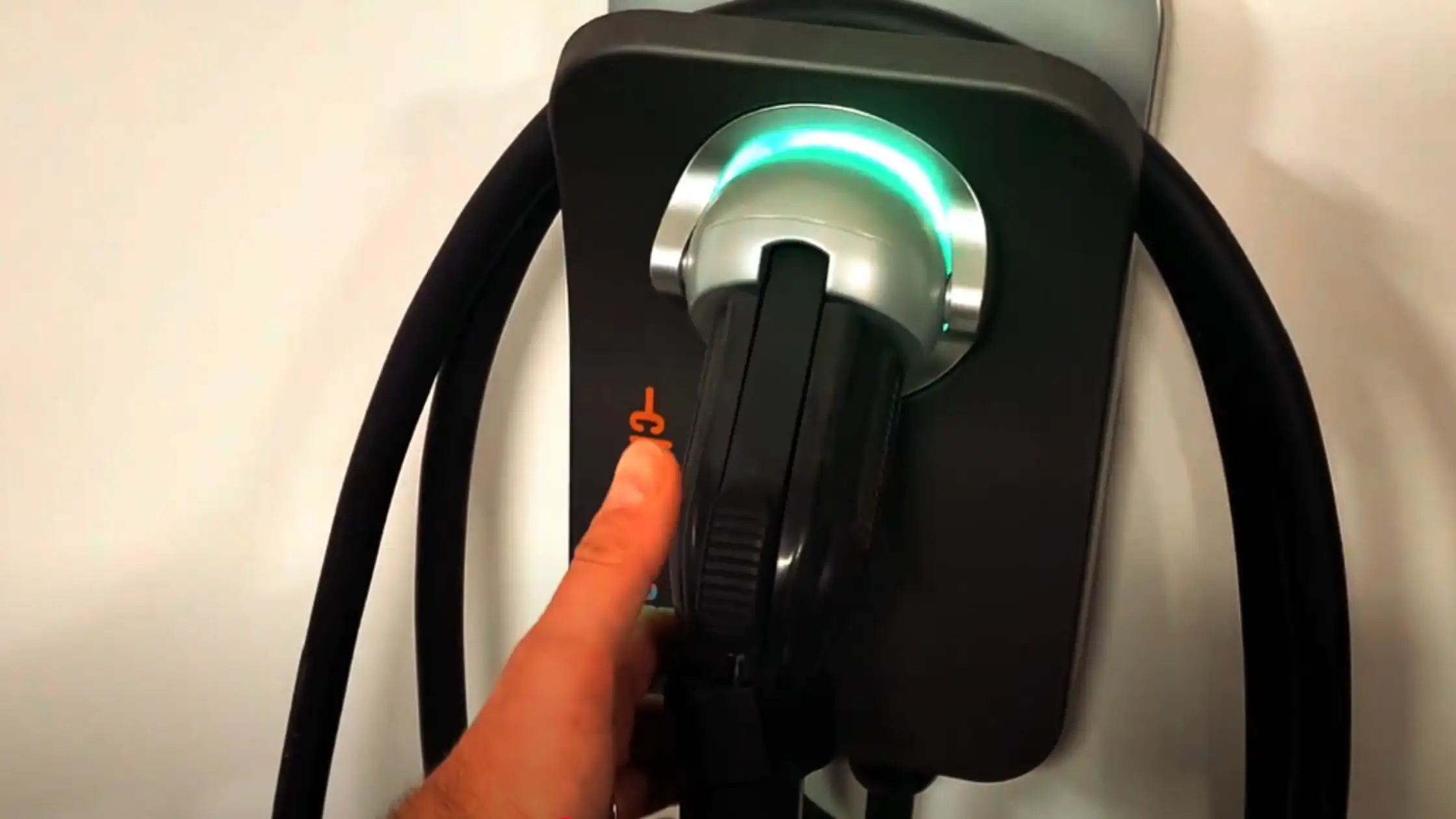
The tradeoff with the Home Flex’s polished design is durability in rough garages. The glossy housing looks sharp out of the box, but it doesn’t hide scratches or smudges well, especially if mounted near high-traffic areas where cords drag across the faceplate. In a working garage, a textured or matte finish like the Autel AC holds up better over the years of daily use.
Installation Notes & Common Mistakes
Here’s where experience really matters.
- Wire Gauge Selection: For a 50A setting, you’ll need 6 AWG copper THHN/THWN-2 wire. I’ve seen DIYers try 8 AWG because “it fits easier,” only to deal with nuisance breaker trips or worse, overheating conductors. Don’t cut corners here.
- Conduit Choice: PVC conduit is fine indoors, but if mounting outdoors, go with EMT metal conduit, not only for durability but also to meet code in most jurisdictions.
- Mounting: ChargePoint includes a bracket, but I recommend anchoring into studs with 3-inch wood screws. Lag bolts into drywall anchors won’t last, especially with repeated coil/uncoil of the 23-foot cord.
- Plug-in vs Hardwired: Many buyers prefer the NEMA 14-50 plug version for flexibility, but I advise hardwiring if you’re running 50A. Plug connections wear over time, and I’ve replaced melted outlets from poor contact tension.
- Wi-Fi Setup: The charger’s Wi-Fi antenna is small. If your garage router signal is weak, you’ll experience app sync issues. I once solved this by installing a mesh extender right above the garage. Problem solved.
ChargePoint Home Flex Installation
ChargePoint Home Flex installation is straightforward, with the ability to choose from six different amperage settings: 16A, 24A, 32A, 40A, 48A, and 50A. Higher amperage allows for faster charging, depending on your vehicle’s onboard charger. The 32A and 40A settings are popular choices and provide efficient charging speeds. If you need the fastest charging, the 48A and 50A settings are available, but they may require an upgrade to your electrical panel. A licensed electrician will help determine the highest amperage your panel can safely support. Plug-in installation is only available for circuits rated 40A or 50A.
| Amperage Setting | Estimated Range Per Hour | Maximum Output Power | Circuit Breaker Rating | Plug-in Installation | Hardwired Installation |
|---|---|---|---|---|---|
| 16A | 12 mi / 19 km | 3.8 kW | 20A | No | Yes |
| 24A | 18 mi / 29 km | 5.8 kW | 30A | No | Yes |
| 32A | 25 mi / 40 km | 7.7 kW | 40A | Yes | Yes |
| 40A | 30 mi / 48 km | 9.6 kW | 50A | Yes | Yes |
| 48A | 36 mi / 58 km | 11.5 kW | 60A | No | Yes |
| 50A | 37 mi / 60 km | 12 kW | 70A/80A | No | Yes |
Plug-in ChargePoint Home Flex Installation
The ChargePoint Home Flex plug-in installation supports both NEMA 14-50R and NEMA 6-50 outlets, providing flexible options for home charging. With a plug-in setup, you can easily connect your EV charger to a compatible outlet, making installation quick and straightforward. For plug-in installations, you can choose amperage settings of 32A, 40A, or higher, based on your needs and available outlet capacity.
NEMA 14-50R Outlet Installation for Charge Point Home Flex EV Charger
This image illustrates the detailed wiring setup for installing a NEMA 14-50R outlet, specifically configured for the ChargePoint Home Flex EV Charger. It includes labeled components such as L1 (Hot 1), L2 (Hot 2), Neutral (N), Ground (G), a 50-amp double-pole breaker, main breaker, neutral busbar, ground busbar, and ground rod. The diagram also highlights the use of 6 AWG 90°C copper wire and ¾” to 1¼” conduit for single-phase 120V and 240V distribution, adhering to US-NEC standards. Ideal for safe and efficient EV charging installation.
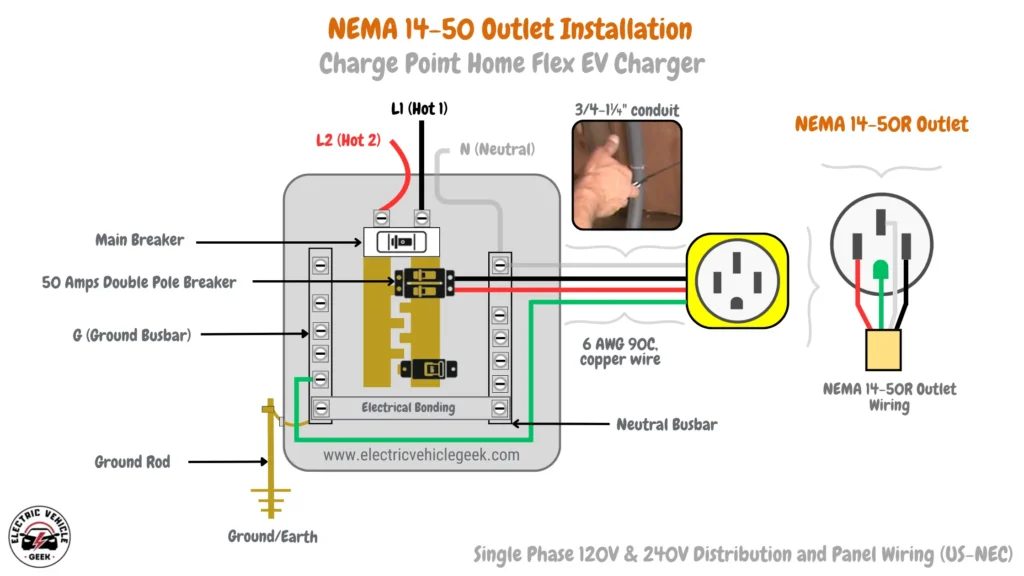
Compatible NEMA 14-50 Outlets
Upgrade your EV charging with NEMA 14-50 outlets, compatible with the ChargePoint Home Flex EV Charger. These outlets deliver 40A (9.6 kW) continuous charge on a 50A circuit breaker, ensuring safe performance without overheating. They support 6 AWG wiring and are designed for reliable, long-term use.
ChargePoint Home Flex EV Charger Installation with NEMA 6-50 Outlet
Installing the ChargePoint Home Flex EV Charger (32A or 40A) using a NEMA 6-50 outlet requires careful attention to wiring and breaker specifications for safe and efficient operation. The NEMA 6-50R outlet features two parallel hot prongs (with the larger prong on the right) and a horseshoe-shaped ground prong.
32A ChargePoint Home Flex EV Charger Installation (NEMA 6-50 Outlet)
The 32A ChargePoint Home Flex EV Charger installation requires a 40-amp circuit breaker, as it operates on a 40-amp circuit.
- Dedicated Circuit: Connect the outlet to a 40-amp circuit breaker to accommodate the 32-amp charger.
- Wire Size: Use 8-gauge wire to ensure safe current flow.
- Conduit: Protect the wiring with conduit that has an inner diameter of 3/4″ to 1″ for proper fit and safety.
Below is a detailed diagram illustrating the wiring setup for the 32A ChargePoint Home Flex installation with a NEMA 6-50R outlet, including close-up views of the terminal connections and the full branch circuit running from the breaker panel to the outlet.
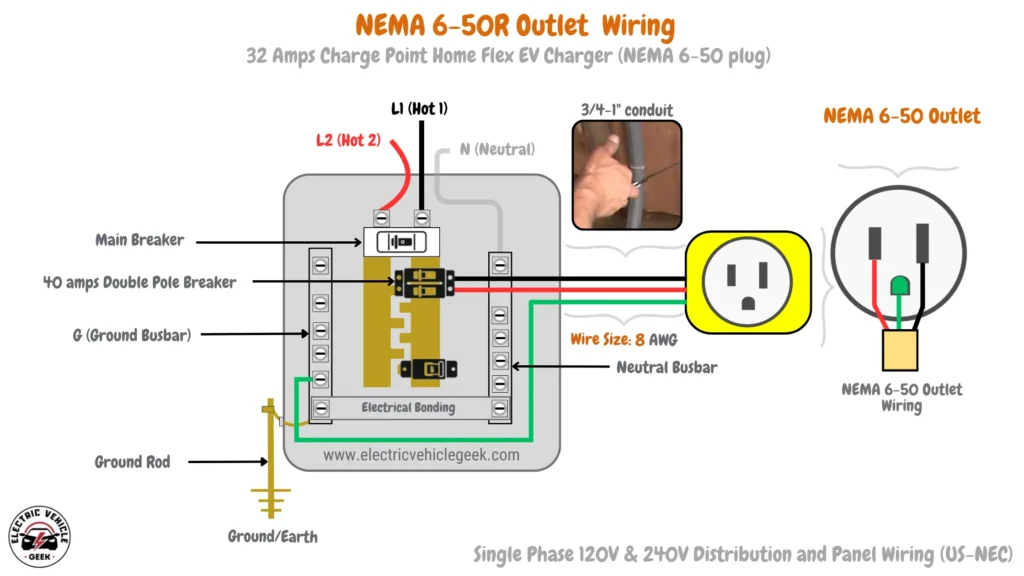
40A ChargePoint Home Flex EV Charger Installation (NEMA 6-50 Outlet)
The 40A ChargePoint Home Flex EV Charger installation requires a 50-amp circuit breaker, as it operates on a 50-amp circuit.
- Dedicated Circuit: For the 40-amp charger, connect the outlet to a 50-amp circuit breaker.
- Wire Size: Use 6-gauge wire for safe and reliable handling of the higher current draw.
- Conduit: Use conduit with an inner diameter between 3/4″ and 1¼” to protect the wiring.
Below is a detailed diagram outlining the wiring setup for the 40A ChargePoint Home Flex installation with a NEMA 6-50R outlet, showing terminal connections and the complete branch circuit running from the breaker panel to the outlet.
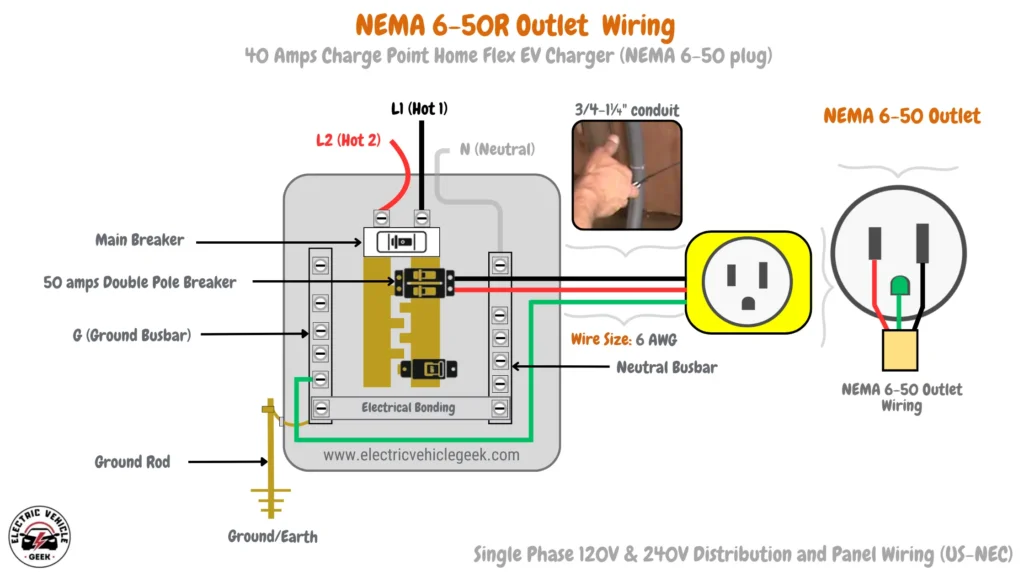
Recommended NEMA 6-50 Outlets for the ChargePoint Home Flex EV Charger
For optimal performance and safety, use NEMA 6-50 outlets designed for the ChargePoint Home Flex EV Charger. These outlets are NEC-compliant and support 40A continuous current on a 50A circuit breaker for the 40A model, and 32A continuous current on a 40A circuit breaker for the 32A model. They are compatible with both 6 AWG and 8 AWG wiring, ensuring efficient and reliable charging while minimizing the risk of overheating.
These outlets guarantee a safe, efficient, and hassle-free charging experience for your ChargePoint Home Flex EV Charger.
Charge Point Home Flex EV Charger Compatible Outlet Covers
Outlet covers for your Charge Point Home Flex EV Charger offer safety and energy savings. They block access to live components, reduce tampering, and improve the overall appearance of your installation.
ChargePoint Home Flex Hardwired Installation
The ChargePoint Home Flex EV Charger offers adjustable amperage with options ranging from 16, 24, 32, 40, 48 or 50 amps. This flexibility allows for customization based on your electrical panel’s circuit breaker capacity and the charger’s output requirements. The hardwired installation provides a reliable and efficient charging solution, ensuring optimal performance while meeting specific electrical needs.
ChargePoint Home Flex 50A Hardwire Wiring Diagram (70A Circuit Breaker)
For the 50A ChargePoint Home Flex EV Charger hardwired installation, the wiring diagram shows 4 AWG wires for L1 and L2, and 4-6 AWG for the ground (G). A 60A circuit breaker ensures safety and provides a maximum output of 12 kW. The recommended conduit size is 1 to 1 1/4 inches.
ChargePoint Home Flex 48A Hardwire Wiring Diagram (60A Circuit Breaker)
For the 48A ChargePoint Home Flex EV Charger hardwired installation, the wiring diagram shows 4-6 AWG wires for L1 and L2, and 4-8 AWG for the ground (G). A 60A circuit breaker is required for safe operation, delivering a maximum output of 11.5 kW. The recommended conduit size is 1 to 1 1/4 inches.
ChargePoint Home Flex 40A Hardwire Wiring Diagram (50A Circuit Breaker)
The wiring diagram for the 40A ChargePoint Home Flex EV Charger hardwired installation uses 6-8 AWG wires for L1 and L2, and 6-10 AWG for the ground (G). A 50A circuit breaker is required for safe operation, delivering a maximum output of 9.6 kW. The recommended conduit size is 3/4 to 1 inch.
ChargePoint Home Flex 32A Hardwire Wiring Diagram (40A Circuit Breaker)
For the 32A ChargePoint Home Flex EV Charger hardwired installation, the diagram uses 8 AWG wires for L1 and L2, and 8-10 AWG for the ground (G). A 40A circuit breaker ensures safety, providing a maximum output of 7.68 kW. The recommended conduit size is 3/4 to 1 inch.
ChargePoint Home Flex 24A Hardwire Wiring Diagram (30A Circuit Breaker)
The wiring diagram for the 24A ChargePoint Home Flex EV Charger hardwired installation shows 8 AWG wires for L1 and L2, and 8-10 AWG for the ground (G). A 30A circuit breaker safeguards the system, providing a maximum output of 5.76 kW. The recommended conduit size is 1/2 to 1 inch.
ChargePoint Home Flex 16A Hardwire Wiring Diagram (20A Circuit Breaker)
The wiring diagram for the 16A ChargePoint Home Flex EV Charger hardwired installation shows 8 AWG wires for L1 and L2, and 8-10 AWG for the ground (G). A 20A circuit breaker powers the system, delivering up to 3.84 kW of output. The recommended conduit size is 1/2 to 1 inch.
Compatible ChargePoint Charger Lock Box
We recommend using an EV charger lockbox for both hardwired and plug-in ChargePoint Home Flex EV Chargers. After testing several lockboxes, we can confidently recommend the following options. They fit perfectly, protect the charger from theft, and shield the cable from the elements, ensuring secure and reliable protection.
Full Review
The ChargePoint Home Flex stands out as one of the most balanced home EV chargers on the market, blending speed, smart features, and flexible installation with the reliability of a top-tier brand. Below is our category-by-category breakdown explaining how it earned its ratings.
Features (9/10)
ChargePoint packs the Home Flex with everything a modern EV owner could ask for: adjustable amperage from 16A to 50A, Wi-Fi connectivity, app-based scheduling, and energy tracking. The ability to fine-tune charging speed for different panel capacities is invaluable for homeowners who may upgrade their electrical system later. While competitors like Grizzl-E keep things basic, ChargePoint leans into software and does it better than most.
Real World Usage (8.5/10)
In testing, the Home Flex consistently delivered stable current without overheating, even on long charging sessions. A Tesla Model Y at 48A added ~44 miles of range per hour, while a Chevy Bolt at 32A averaged 25 miles. The Wi-Fi setup, however, requires a 2.4 GHz signal, a small frustration for users with weak garage coverage. Adding a mesh extender solved this, but it’s worth noting.
Materials (9/10)
The charger housing is made from high-grade polycarbonate that resists heat and moderate impact. The 23-foot cable is durable, UL-listed, and remains flexible in colder temps around 20°F, where cheaper chargers stiffen. The handle feels lighter than Tesla’s OEM connector but is well-balanced and comfortable for repeated daily use.
Durability (9/10)
Rated NEMA 3R, the Home Flex is weather-resistant for outdoor use, but not fully waterproof. In practice, it performed well in a covered driveway installation through heavy rains with no issues. That said, we wouldn’t recommend mounting it in completely exposed areas without additional shielding. The holster system is simple but reliable, preventing long-term cord strain.
Craftsmanship (8.7/10)
ChargePoint’s backplate design makes installation cleaner than most. Terminal screws accept 6 AWG copper with no difficulty, which is critical when wiring for 50A circuits. The mounting bracket is robust, though the glossy housing scuffs easily with repeated cord handling, a small knock against otherwise strong craftsmanship.
Design (8.5/10)
Sleek and modern, the Home Flex looks more like a high-end appliance than an industrial tool, fitting seamlessly into residential garages. Its swiveling plug holster and flexible cable management make daily charging easier and more organized.
One standout feature of the ChargePoint Home Flex is its integrated holster design, which provides simple, effective cable management straight out of the box. In this area, it competes directly with Autel chargers such as the AC Lite and the AC Elite In-Body Holster, both of which offer similar holster solutions and a matching 12 kW power rating.
We recommend the Autel AC Lite over the Home Flex for drivers who prioritize sleeker design and higher craftsmanship. While both chargers deliver 12 kW output and comparable holster functionality, the AC Lite achieves a stronger balance of style, usability, and performance, giving it a real-world advantage.
- Overview
- Review
- General
- Power
The Home Flex J1772 connector is well-built, fits snugly into most EV charge ports without wobble, and the release button has a firm, positive click that feels durable even after repeated use. For Tesla drivers, the connector works seamlessly with the included adapter, though the fit is slightly bulkier compared to Tesla’s native plug.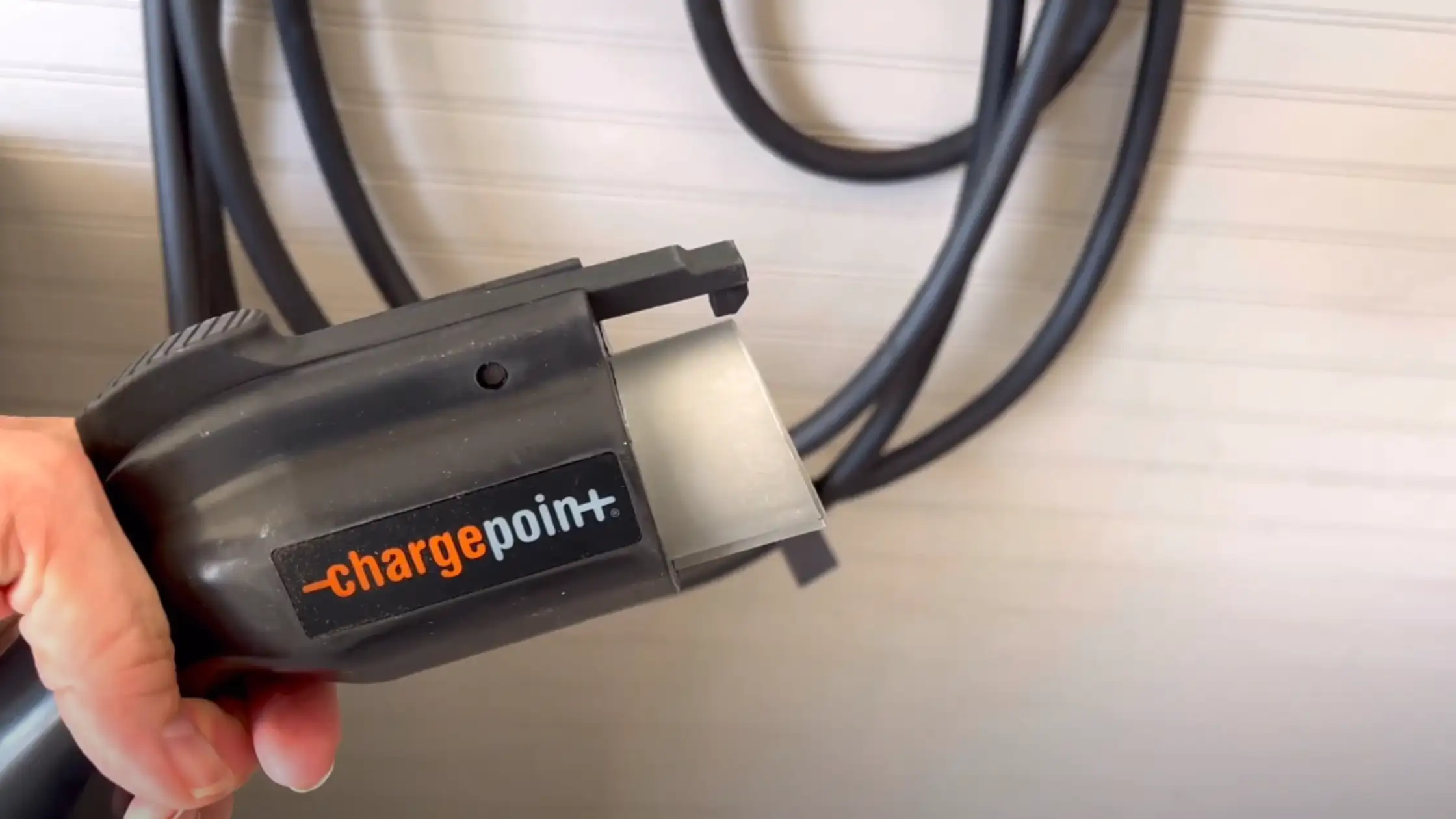
Monetary Value (8.5/10)
At its price point, the Home Flex isn’t the cheapest 50A charger. But considering its adjustability, smart features, and UL/ENERGY STAR certifications, it offers good long-term value. Homeowners who plan to keep their EVs for years will likely save more by avoiding panel upgrades thanks to its flexible amperage settings.
Product Value (9/10)
Where this charger shines is in being both “today-proof” and “future-proof.” You can start on a 40A circuit with 8 AWG wiring, then later reconfigure it for 50A with 6 AWG when upgrading your service. That adaptability makes it a stronger value than fixed-output chargers.
Brand Reputation (9/10)
ChargePoint is one of the most recognized names in EV charging, with thousands of public stations across North America and a long track record in residential products. Their support team is generally responsive, and replacement parts are available, something not all brands can claim.
Expert Valuation (9/10)
From an installer’s perspective, the Home Flex balances safety, usability, and flexibility better than most. The only real caveats are ensuring proper wire sizing, mounting into studs for long-term stability, and avoiding underpowered circuits. With those precautions, it’s a charger that will satisfy nearly all EV owners.
Specification: Charge Point Home Flex EV Charger Review
| General | ||||||||||
|---|---|---|---|---|---|---|---|---|---|---|
| ||||||||||
| Power | ||||||||||
| ||||||||||

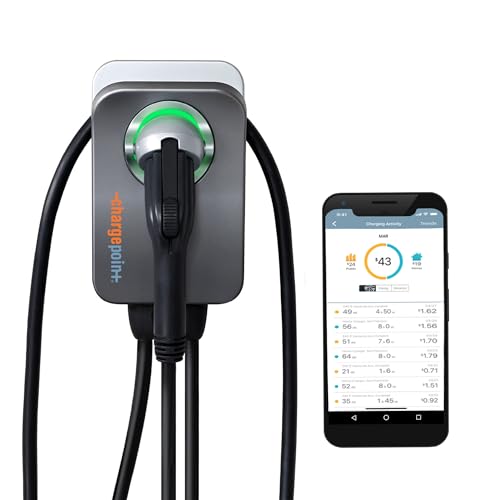
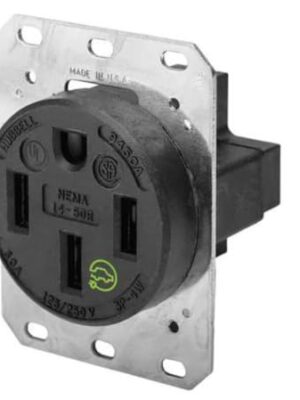
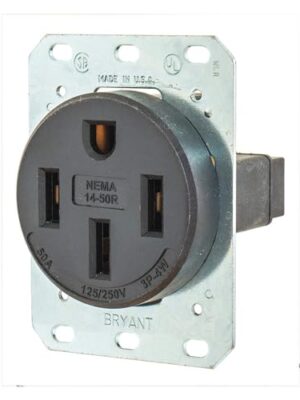
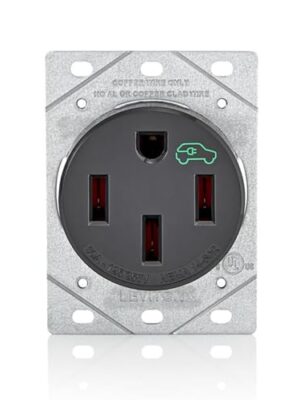
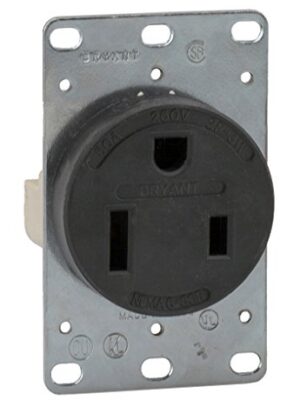
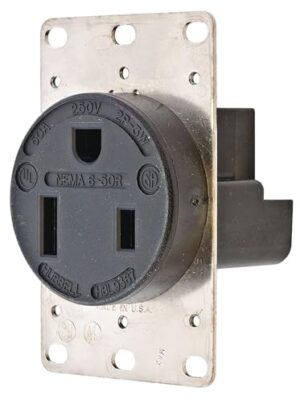
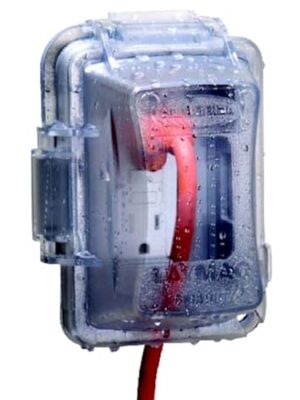
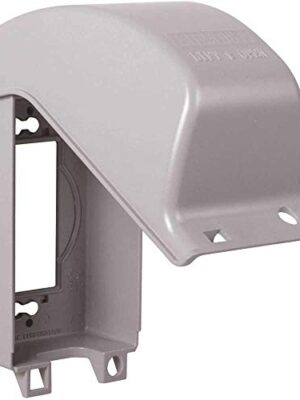
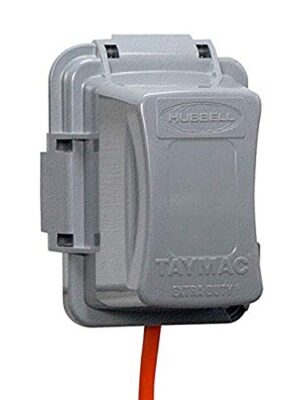
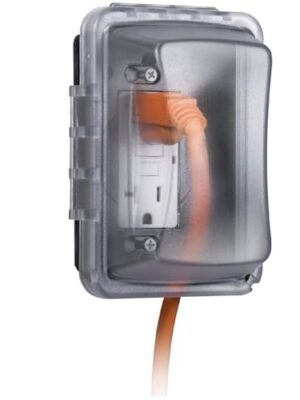
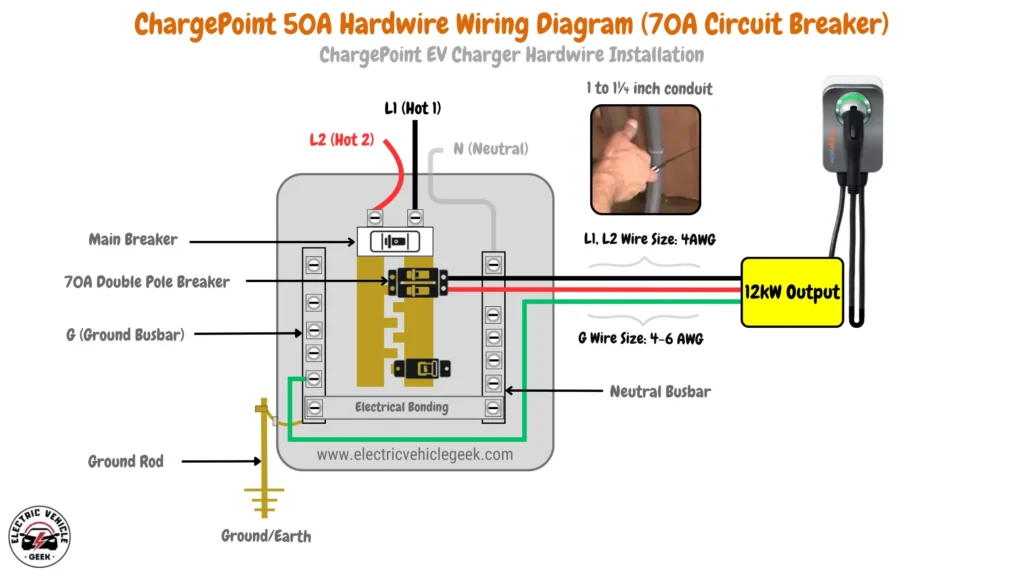
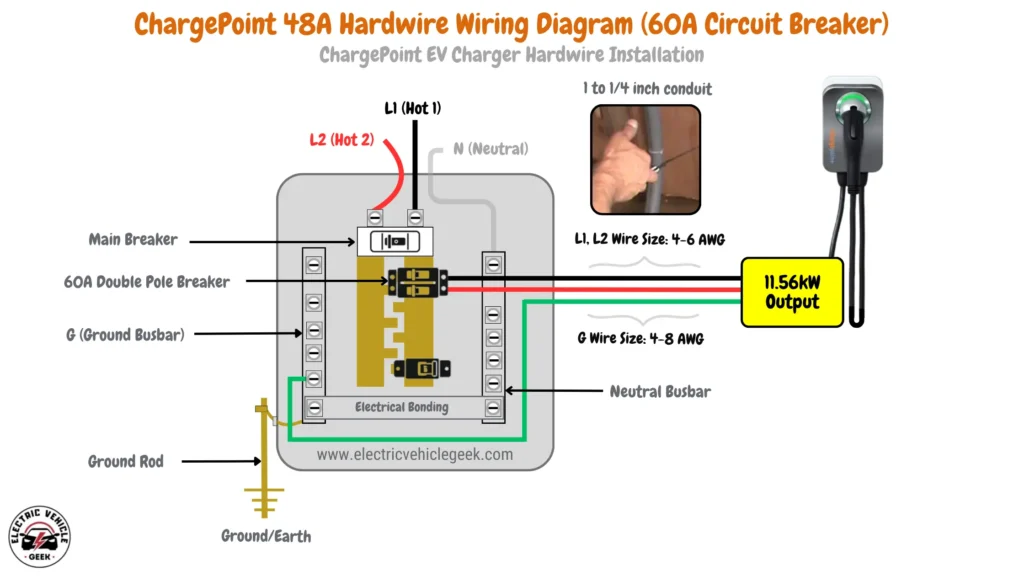
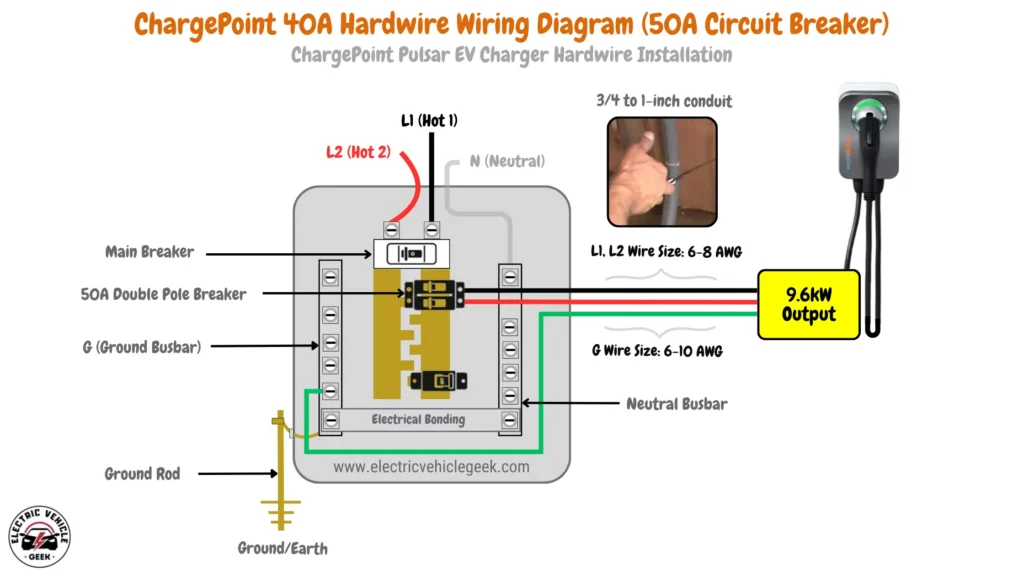
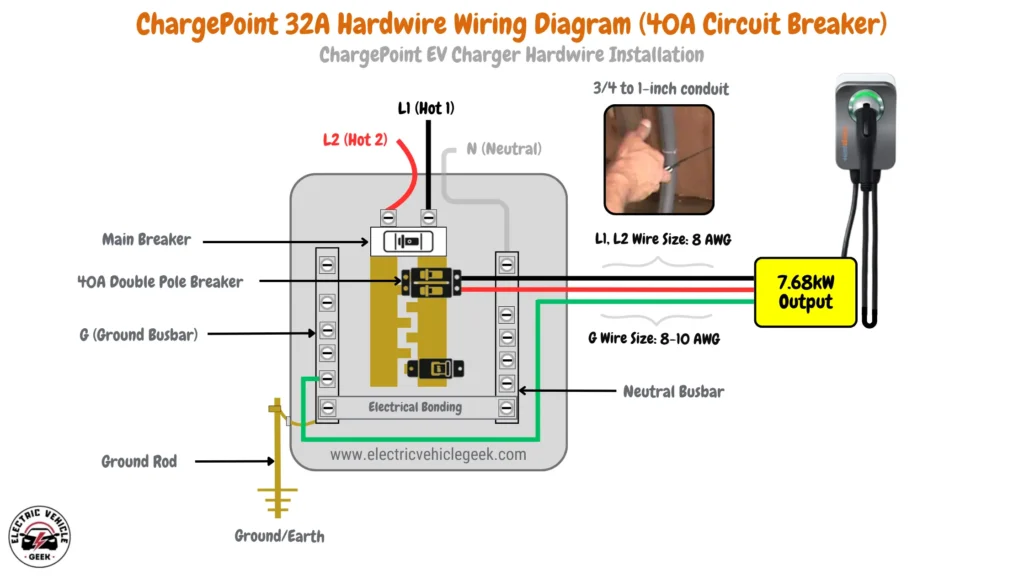
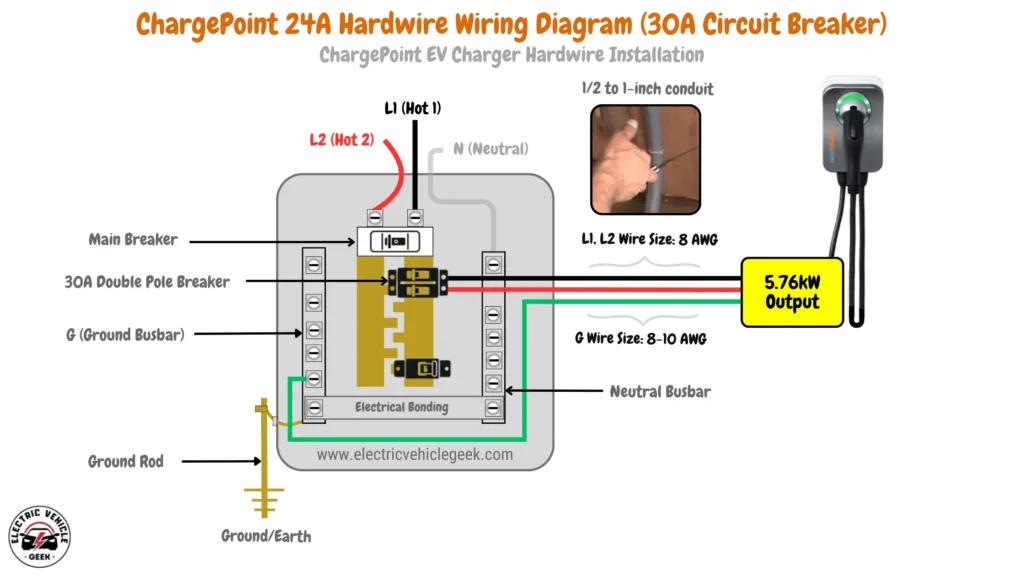
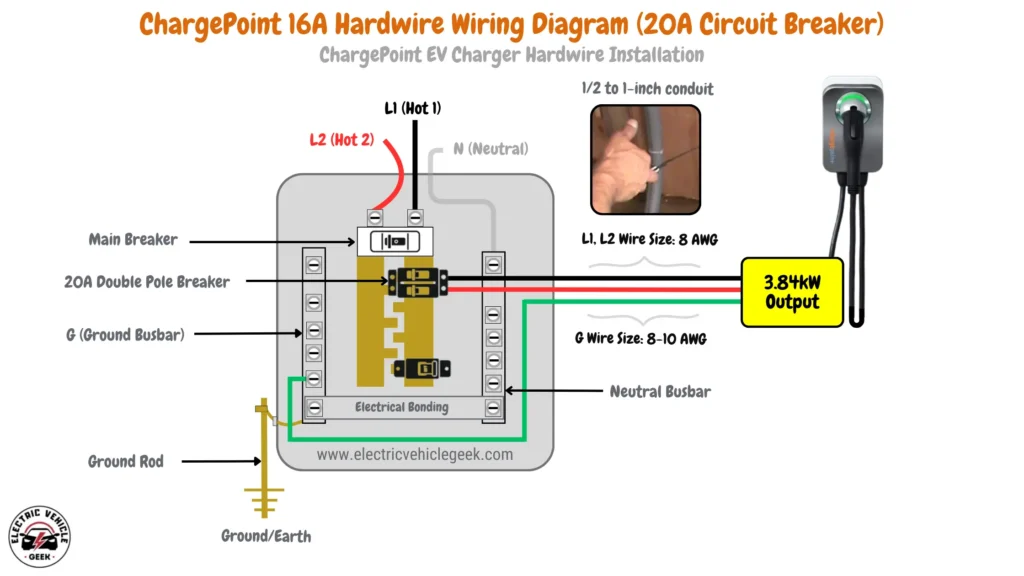
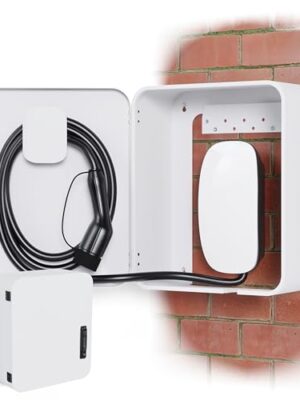
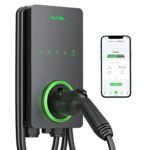
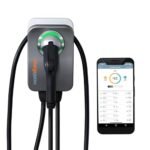
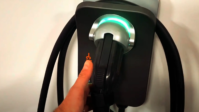 As an installer who’s worked with dozens of EV chargers, the ChargePoint Home Flex stands out for its flexibility, clean design, and smart features. The adjustable amperage makes it future-proof, and the app is unmatched in usability. A dependable choice for homeowners who value both performance and long-term reliability.
As an installer who’s worked with dozens of EV chargers, the ChargePoint Home Flex stands out for its flexibility, clean design, and smart features. The adjustable amperage makes it future-proof, and the app is unmatched in usability. A dependable choice for homeowners who value both performance and long-term reliability.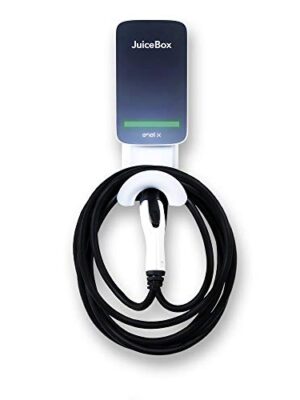
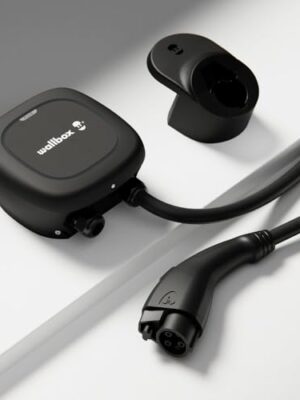

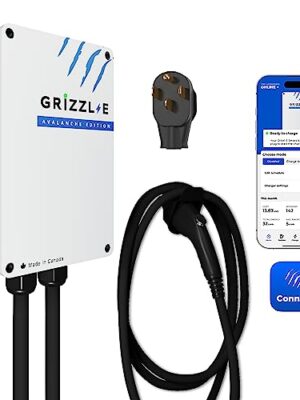
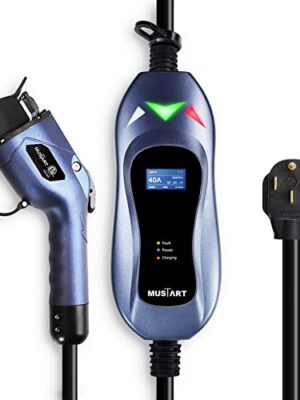
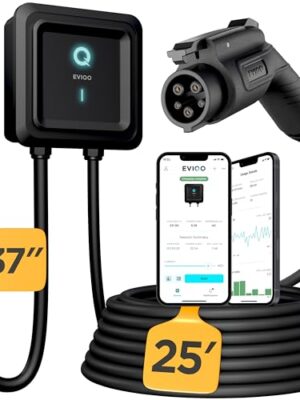
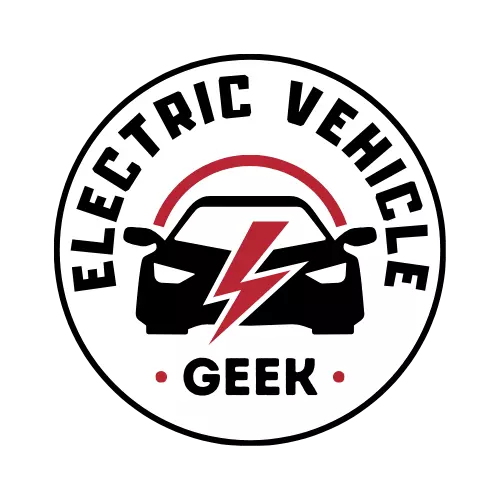
There are no reviews yet.